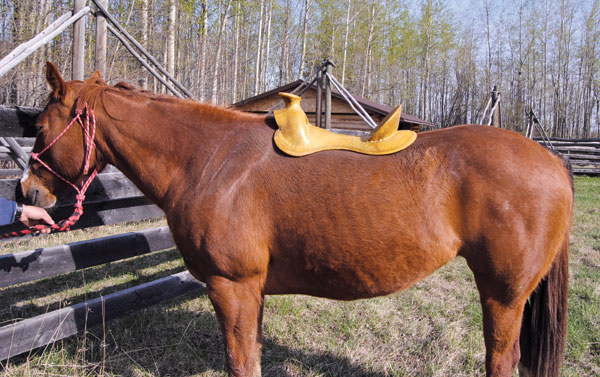
This can be a common expression among horse enthusiasts. The more a person rides or the more the horse has to work, the more important it is to have a good fit.
When a horse develops white hairs or has areas of swelling or pain on their back, it is an indication that the saddle is causing discomfort and damage.
How do you know if a saddle fits properly? The basics are simple — the shape of the underside of the saddle should closely match the shape of the horse’s back with no high pressure points. Fitting is all about shape, not “sizes”. There is no consistent industry standard so the same “sizes” or “angle” from different makers fit differently.
The spread between the bars should match the body size of the horse. The “angle” between the bars at the front needs to match the angle of the horse’s withers. This “angle” changes along the bar as the horse’s back widens, and this change is called twist. The curve from front to back (rock) needs to closely resemble the curve of the back under the bar so it contacts all along, without lifting off excessively at the ends (too much rock in the bar) or sitting at both ends but missing in the middle (too little rock, called
bridging). The curve side to side on the bar (crown) should also match the horse without being concave. The edges need enough curve (relief) built in to avoid high pressure points.
The more bar surface area on the horse, the better the distribution of the rider’s weight. Whatever reduces bar contact with the horse results in higher pressures on the areas that remain in contact with the horse. When the shapes differ greatly, the pressures get too high.
As horses move, their back shape changes. When the tree bars are large and closely resemble the back shape of the horse with enough relief on the bar edges and front and back bar tips, there will still be enough surface area on the bars to evenly spread the weight and pressure, even when the entire bar doesn’t have contact.
Saddle position is critical. The shapes will no longer match if the saddle is sitting in the wrong place. One very common mistake is putting a saddle too far forward so it sits on the horse’s shoulder blades, compressing muscle between bone and saddle. The front of the bar needs to be behind the back of the shoulder blade. This is where the saddle will settle if you shake it from side to side after you set it on the horse. The correct position of the saddle is set by the tree on the horse, not the cinch position, so an angled cinch or latigos are OK.
One tree or saddle can fit a variety of horses correctly as long as the variance in back shape is not too great because good western saddle trees are built with a lot of leeway. This is due to large surface area and good edge relief. However, if there is a pattern of soreness, skin or muscle damage, or major disposition changes, it’s time to search for solutions.
The basics of saddle fit are simple — ensure the saddle is in the correct position, check for high pressure areas, do not overly tighten the latigos, and loosen the cinch if you get off for a break. If you have problems, have a reputable saddle maker assist in checking your current saddle, and give them the information they ask for about your horses when ordering a new saddle to get a good fit.
Editor’s note: Thanks to Denise and Rod for providing examples of trees on horses they don’t fit to illustrate this article. For more on saddle fit, Denise keeps an interesting blog on www.rodnikkel.com
